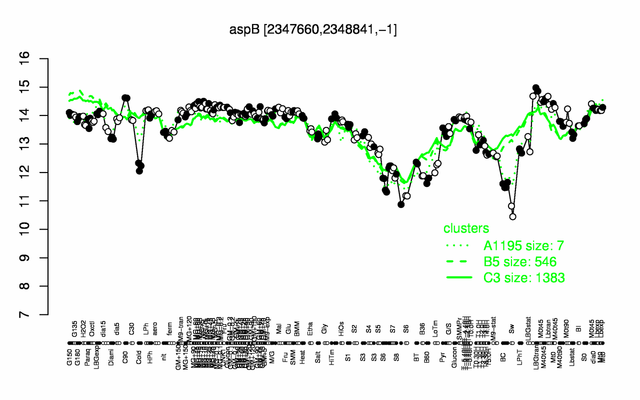Difference between revisions of "AspB"
| Line 120: | Line 120: | ||
** number of protein molecules per cell (minimal medium with glucose and ammonium, early stationary phase after glucose exhaustion): 2849 {{PubMed|21395229}} | ** number of protein molecules per cell (minimal medium with glucose and ammonium, early stationary phase after glucose exhaustion): 2849 {{PubMed|21395229}} | ||
| + | ** number of protein molecules per cell (minimal medium with glucose and ammonium, late stationary phase after glucose exhaustion): 3270 {{PubMed|21395229}} | ||
| + | ** number of protein molecules per cell (minimal medium with glucose and ammonium, exponential phase): 7546 {{PubMed|21395229}} | ||
| + | ** number of protein molecules per cell (minimal medium with glucose and ammonium, early stationary phase after glucose exhaustion): 2849 {{PubMed|21395229}} | ||
** number of protein molecules per cell (minimal medium with glucose and ammonium, late stationary phase after glucose exhaustion): 3270 {{PubMed|21395229}} | ** number of protein molecules per cell (minimal medium with glucose and ammonium, late stationary phase after glucose exhaustion): 3270 {{PubMed|21395229}} | ||
Revision as of 14:03, 17 April 2014
- Description: aspartate transaminase
| Gene name | aspB |
| Synonyms | |
| Essential | no |
| Product | aspartate transaminase |
| Function | biosynthesis of aspartate |
| Gene expression levels in SubtiExpress: aspB | |
| Metabolic function and regulation of this protein in SubtiPathways: aspB | |
| MW, pI | 42 kDa, 5.298 |
| Gene length, protein length | 1179 bp, 393 aa |
| Immediate neighbours | asnS, ypmB |
| Sequences | Protein DNA DNA_with_flanks |
Genetic context 
This image was kindly provided by SubtiList
| |
Expression at a glance PubMed
| |
Contents
Categories containing this gene/protein
biosynthesis/ acquisition of amino acids, most abundant proteins
This gene is a member of the following regulons
The gene
Basic information
- Locus tag: BSU22370
Phenotypes of a mutant
Database entries
- BsubCyc: BSU22370
- DBTBS entry: no entry
- SubtiList entry: [1]
Additional information
The protein
Basic information/ Evolution
- Catalyzed reaction/ biological activity: L-aspartate + 2-oxoglutarate = oxaloacetate + L-glutamate (according to Swiss-Prot)
- Protein family: TCR/tet family (according to Swiss-Prot)
- Paralogous protein(s):
Extended information on the protein
- Kinetic information:
- Modification:
- Effectors of protein activity:
- Localization: cytoplasm (according to Swiss-Prot)
Database entries
- BsubCyc: BSU22370
- Structure: 1J32 (from Phormidium lapideum, 45% identity, 66% similarity)
- UniProt: P53001
- KEGG entry: [2]
- E.C. number: 2.6.1.1
Additional information
Expression and regulation
- Regulation: constitutive
- Regulatory mechanism:
- Additional information:
- belongs to the 100 most abundant proteins PubMed
- number of protein molecules per cell (minimal medium with glucose and ammonium): 10916 PubMed
- number of protein molecules per cell (complex medium with amino acids, without glucose): 13715 PubMed
- number of protein molecules per cell (minimal medium with glucose and ammonium, early stationary phase after glucose exhaustion): 2849 PubMed
- number of protein molecules per cell (minimal medium with glucose and ammonium, late stationary phase after glucose exhaustion): 3270 PubMed
- number of protein molecules per cell (minimal medium with glucose and ammonium, exponential phase): 7546 PubMed
- number of protein molecules per cell (minimal medium with glucose and ammonium, early stationary phase after glucose exhaustion): 2849 PubMed
- number of protein molecules per cell (minimal medium with glucose and ammonium, late stationary phase after glucose exhaustion): 3270 PubMed
Biological materials
- Mutant:
- Expression vector:
- lacZ fusion:
- GFP fusion:
- two-hybrid system:
- Antibody:
Labs working on this gene/protein
Your additional remarks
References